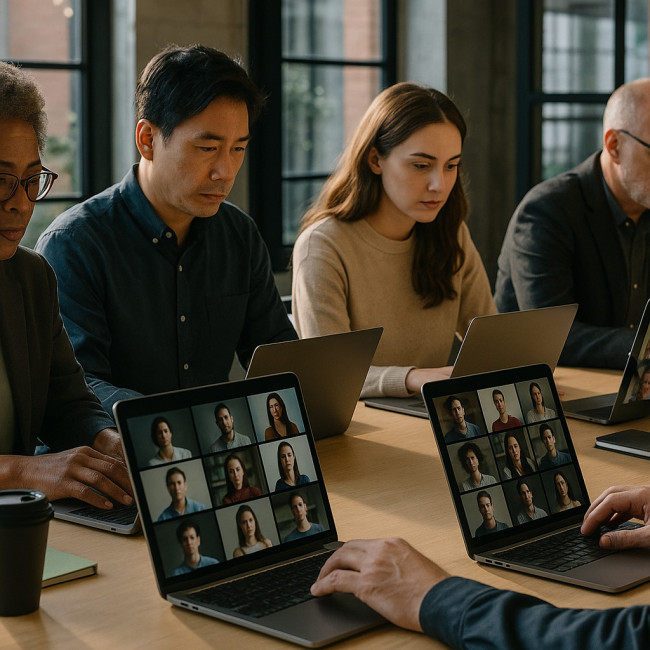Digital casting calls: how to evaluate online submissions without bias
Scrolling through hundreds of self-tapes can feel overwhelming. Yet every click shapes the diversity, creativity and success of your production. This guide shows you how to assess digital casting calls fairly, minimise unconscious bias and select the best talent for your brief—without sacrificing speed.
Why bias sneaks into digital casting workflows
Digital casting calls promise objectivity, but hidden shortcuts in our brains—heuristics—often influence decisions. Thumbnail impressions, lighting quality or a familiar accent may sway you before you even watch the performance. Recognising these traps is the first step to dismantling them.
Common bias triggers in online submissions
- Thumbnail aesthetics – Colour grading, wardrobe and framing can create undue preference.
- Tech quality – Fast judgement against performers with lower-resolution cameras or budget microphones.
- Name, age or location cues – Quick assumptions about cultural fit, reliability or scheduling.
- Algorithmic filters – Platforms that sort by popularity can bury under-represented voices.
Build a bias-resistant evaluation framework
Replace gut feelings with clear, weighted criteria. Use the following table to craft a scoring sheet that everyone on the panel understands.
| Criterion | Weight (%) | Objective metric | Bias-proofing tip |
|---|---|---|---|
| Role suitability | 40 | Script alignment, emotional range | Evaluate voice or movement before reading résumé |
| Technical delivery | 20 | Clarity of diction, sound levels | Provide tech guidelines in advance for parity |
| Availability & logistics | 15 | Calendar match, travel needs | Ask in a separate form—review after performance score |
| Collaboration cues | 15 | Peer endorsements, past teamwork | Look for verified reviews rather than follower counts |
| Unique value | 10 | Special skills, languages | Invite candidates to note extras in blind text field |
Step-by-step: running a fair digital casting session

Picture a sun-drenched rehearsal loft where a multicultural group of casting professionals huddle over open laptops, their faces illuminated by both daylight and the glow of thumbnail grids. Some lean forward to jot notes, others exchange quick, thoughtful glances as they pause a video to discuss emotional beats. Around them, coffee cups and colour-coded score sheets hint at the structured process you are about to implement: anonymising submissions, applying weighted criteria, recording rationales and double-checking inclusion metrics. This busy yet harmonious scene captures the heart of fair digital casting—technology and human judgement working in concert to surface talent that might otherwise be overlooked—while visually reinforcing every checklist item that follows.
- Standardise submission instructions. Offer a lighting diagram, audio spec and framing reference. Publish them in the brief and link to an example self-tape. Candidates appreciate clarity; you gather consistent material.
- Remove identifying data. Ask an assistant or casting tool to hide names, demographic tags and social handles during first-round viewing. Platforms like Artfolio let you toggle “anonymous mode” with one click.
- Score individually before group discussion. Panelists note their ratings privately, then compare. This prevents early dominant voices from steering the room.
- Use weighted criteria. Apply the table above. Automated sheets calculate totals and flag close calls for deeper debate.
- Document rationales. For each shortlist decision, write one sentence explaining why. The habit keeps everyone accountable.
- Cross-check diversity metrics. After ranking, reveal demographics to ensure the list reflects your inclusion targets and relevant union requirements.
- Give constructive feedback. Even a concise, kind note fosters goodwill and strengthens your brand.
Tools that support unbiased casting
- Blind review features in platforms such as Artfolio's collaboration job board hide photos until scores are locked.
- Metadata filters that sort by skill tags rather than popularity, similar to the approach in inclusive casting calls.
- Peer endorsement badges—explored in depth in this peer endorsement guide—verify collaboration history without revealing personal traits.
- Diversity analytics dashboards to track audition pools against targets, complementing the techniques in diversity checklist workflows.
Mitigate algorithmic bias
Recommendation engines can entrench homogeneity. Counteract this by rotating the order of submissions for each reviewer and setting time limits to encourage equal attention across the board.
Audit the platform
Quarterly, request data from your casting software: acceptance rates by ethnicity, gender and age range. Compare against previous cycles. Sudden drops or spikes flag systemic issues that merit immediate tweaks.
Train your casting panel
Unconscious bias training pays dividends. Run a 45-minute refresher before major calls. Combine micro-learning videos with discussion prompts:
- Spot the bias: share two comparable tapes with different production quality.
- Language watch: review how panelists describe an audition—words like “looks professional” often mask socio-economic bias.
Beyond bias: building an inclusive reputation
Fair processes attract stronger talent pools. Actors swap notes fast; a transparent system boosts your brand and widens future reach.
Publish your commitment
Add a short statement on your website outlining your bias-reduction measures. Include statistics from past calls—for example, “57 % of last season's cast identified as BIPOC and 52 % as women.” Evidence builds trust.
Quiz: test your bias-busting knowledge
FAQ
- How many reviewers do I need to reduce individual bias?
- At least three independent reviewers provide sufficient balance. Their combined scores smooth out personal preferences.
- Should I request demographic data from applicants?
- Yes, but in a separate, optional form. Data is used solely for post-evaluation inclusion checks, not for performance scoring.
- What if poor video quality hides an actor's true ability?
- Offer a free reshoot window with technical guidelines. Standard support raises fairness without delaying the schedule.
- Can automated AI scoring replace human judgement?
- AI can flag objective markers like audio peaks but lacks nuanced artistic insight. Use it as a supplement, never a replacement.
- How do I communicate rejection without discouraging talent?
- Send concise, specific feedback and remind candidates of future calls. Offering resources keeps doors open for growth.
Take action now
You have the framework, tools and mindset to run digital casting calls that champion fairness. Update your next brief, set up blind review filters and schedule bias training for your panel. The talent—and your future audience—will thank you.
Ready to overhaul your digital casting process? Implement the checklist above in your next call and share your results with the community.











